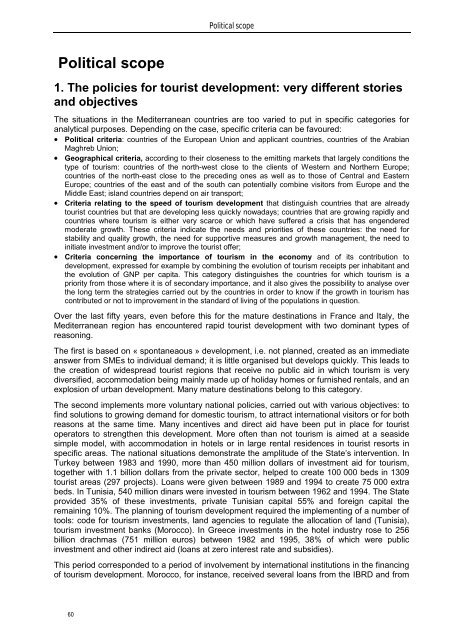dossier sur le tourisme et le développement durable
dossier sur le tourisme et le développement durable
dossier sur le tourisme et le développement durable
Create successful ePaper yourself
Turn your PDF publications into a flip-book with our unique Google optimized e-Paper software.
Political scope<br />
60<br />
Political scope<br />
1. The policies for tourist development: very different stories<br />
and objectives<br />
The situations in the Mediterranean countries are too varied to put in specific categories for<br />
analytical purposes. Depending on the case, specific criteria can be favoured:<br />
• Political criteria: countries of the European Union and applicant countries, countries of the Arabian<br />
Maghreb Union;<br />
• Geographical criteria, according to their closeness to the emitting mark<strong>et</strong>s that largely conditions the<br />
type of tourism: countries of the north-west close to the clients of Western and Northern Europe;<br />
countries of the north-east close to the preceding ones as well as to those of Central and Eastern<br />
Europe; countries of the east and of the south can potentially combine visitors from Europe and the<br />
Midd<strong>le</strong> East; island countries depend on air transport;<br />
• Criteria relating to the speed of tourism development that distinguish countries that are already<br />
tourist countries but that are developing <strong>le</strong>ss quickly nowadays; countries that are growing rapidly and<br />
countries where tourism is either very scarce or which have suffered a crisis that has engendered<br />
moderate growth. These criteria indicate the needs and priorities of these countries: the need for<br />
stability and quality growth, the need for supportive mea<strong>sur</strong>es and growth management, the need to<br />
initiate investment and/or to improve the tourist offer;<br />
• Criteria concerning the importance of tourism in the economy and of its contribution to<br />
development, expressed for examp<strong>le</strong> by combining the evolution of tourism receipts per inhabitant and<br />
the evolution of GNP per capita. This category distinguishes the countries for which tourism is a<br />
priority from those where it is of secondary importance, and it also gives the possibility to analyse over<br />
the long term the strategies carried out by the countries in order to know if the growth in tourism has<br />
contributed or not to improvement in the standard of living of the populations in question.<br />
Over the last fifty years, even before this for the mature destinations in France and Italy, the<br />
Mediterranean region has encountered rapid tourist development with two dominant types of<br />
reasoning.<br />
The first is based on « spontaneaous » development, i.e. not planned, created as an immediate<br />
answer from SMEs to individual demand; it is litt<strong>le</strong> organised but develops quickly. This <strong>le</strong>ads to<br />
the creation of widespread tourist regions that receive no public aid in which tourism is very<br />
diversified, accommodation being mainly made up of holiday homes or furnished rentals, and an<br />
explosion of urban development. Many mature destinations belong to this category.<br />
The second imp<strong>le</strong>ments more voluntary national policies, carried out with various objectives: to<br />
find solutions to growing demand for domestic tourism, to attract international visitors or for both<br />
reasons at the same time. Many incentives and direct aid have been put in place for tourist<br />
operators to strengthen this development. More often than not tourism is aimed at a seaside<br />
simp<strong>le</strong> model, with accommodation in hotels or in large rental residences in tourist resorts in<br />
specific areas. The national situations demonstrate the amplitude of the State’s intervention. In<br />
Turkey b<strong>et</strong>ween 1983 and 1990, more than 450 million dollars of investment aid for tourism,<br />
tog<strong>et</strong>her with 1.1 billion dollars from the private sector, helped to create 100 000 beds in 1309<br />
tourist areas (297 projects). Loans were given b<strong>et</strong>ween 1989 and 1994 to create 75 000 extra<br />
beds. In Tunisia, 540 million dinars were invested in tourism b<strong>et</strong>ween 1962 and 1994. The State<br />
provided 35% of these investments, private Tunisian capital 55% and foreign capital the<br />
remaining 10%. The planning of tourism development required the imp<strong>le</strong>menting of a number of<br />
tools: code for tourism investments, land agencies to regulate the allocation of land (Tunisia),<br />
tourism investment banks (Morocco). In Greece investments in the hotel industry rose to 256<br />
billion drachmas (751 million euros) b<strong>et</strong>ween 1982 and 1995, 38% of which were public<br />
investment and other indirect aid (loans at zero interest rate and subsidies).<br />
This period corresponded to a period of involvement by international institutions in the financing<br />
of tourism development. Morocco, for instance, received several loans from the IBRD and from
















